Page 1336 - Veterinary Immunology, 10th Edition
P. 1336
VetBooks.ir
FIG. 40.2 The structure of a typical retrovirus such as feline
leukemia virus or feline lentivirus.
On exposure to FeLV, about 70% of cats become infected, but the
remaining 30% do not. Of the infected cats, about 60% become
immune and 40% become viremic. Of the viremic cats, 10% cure
spontaneously, whereas the remaining 90% remain infected for life.
Of these persistently viremic animals, about 15% live normal
healthy lives, but the remaining animals die within 3 to 5 years
from FeLV disease. Lymphoid tumors develop in 15% to 20% of
FeLV-infected cats. Persistently viremic cats have a half-life of 1
year.
Once FeLV infects a cat, the virus first grows in the lymphoid
tissues of the pharynx and tonsils. This is followed by a transient
viremia as it spreads throughout the body and infects the other
lymphoid organs. A mild lymphopenia and neutropenia occur 1 to
2 weeks after infection. Antibodies develop between 7 and 42 days
after the onset of infection, and the virus is cleared between 28 and
42 days. Virus can be found in the thymus at day 1, in blood
between 2 and 145 days, and in lymphoid organs between 3 and 28
days. Some cats may become latently infected where the virus
persists in the bone marrow and virus-neutralizing antibodies are
present.
FeLV causes multiple cancers such as lymphosarcomas,
1336

